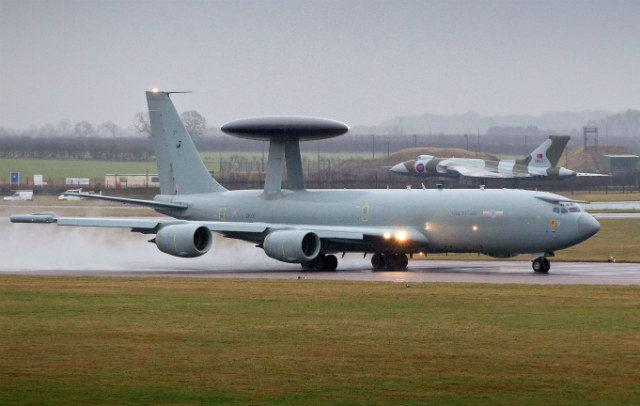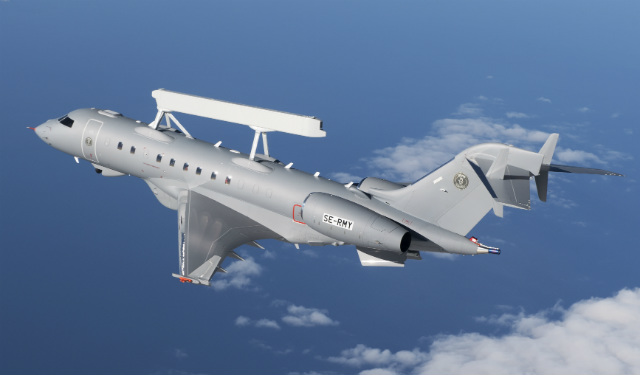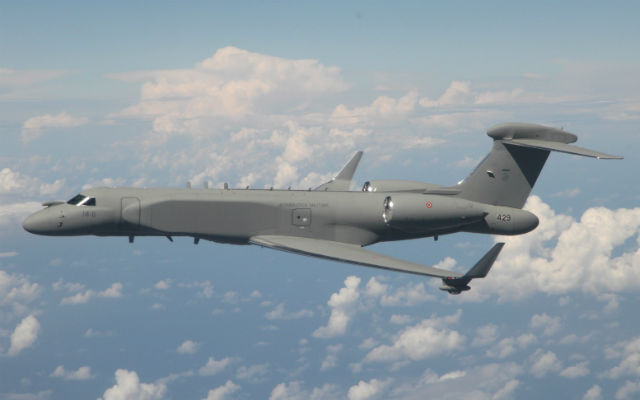Rival producers of airborne early warning and control/battle management aircraft are stepping up their efforts to halt a non-competitive acquisition of the Boeing/Northrop Grumman E-7 Wedgetail system by the UK.
In a letter to parliamentary Defence Committee chairman Julian Lewis on 15 October, Andrew Walton, head of Saab UK, outlined the company's proposed solution for replacing the Royal Air Force's Northrop E-3D Sentry fleet.
This would involve integrating Saab's Erieye active electronically scanned array radar and mission system equipment on board the service's in-use Airbus A330 Voyager tanker/transports. It would also introduce Saab-developed electronic warfare equipment, "giving unparalleled levels of survivability in the most challenging of scenarios".

Crown Copyright
Referring to "several thousand hours spent with Airbus to understand and analyse the work required", Walton says: "Our evidence indicates that the A330 represents the least risk of any platform onto which we have integrated Erieye."
While this would reduce programme costs by removing the need to acquire new aircraft to replace the six-strong Sentry fleet, he adds: "The A330 has ample power and range to be able to perform an E-3D function in addition to its existing transportation and refuelling roles."
Saab's studies indicate that a first aircraft could be modified within less than three years at Airbus Defence & Space's Getafe facility near Madrid, with subsequent examples requiring nine months each for modification work performed in the UK.
"In the expectation that a competition would take place, we have hosted a number of visits to our facilities in Gothenburg, where officials have been briefed on Erieye capabilities; we have also taken part in multiple meetings with officials in the UK," Walton reveals.
Following a request by the Ministry of Defence, the company also offered to provide classified data to its Defence Equipment and Support organisation and the RAF's Air Command, but "both declined to take delivery".
"Without examining the classified data, it is impossible to understand and judge the performance of the sensor and mission system," Walton says.
Defence secretary Gavin Williamson in early October confirmed that the UK is in early discussions with Boeing linked to a potential E-7 purchase, describing the 737-based system as "the stand-out performer in our pursuit of a new battlefield surveillance aircraft".
Challenging this conclusion, Walton says: "MoD officials have been briefed on some of our capabilities, but at no time have we seen a UK requirement against which we can tailor our offer." Additionally, "no analysis of how we integrate our system onto other aircraft has been conducted by the MoD", he notes.
"We are concerned by the lack of competition and the lack of dialogue and response from MoD," says Walton, who notes that Saab's "significant investment in the UK" is premised on an understanding that the nation is committed to "fair and transparent, free-market competition".
Saab points to the proven performance of its radar design, noting: "We underwrite 98.5% availability of Erieye." The sensor is currently operated by eight nations, on the Embraer EMB-145, Saab 340 and Saab 2000 platforms.
Walton also highlights its in-development Erieye ER version, which will be used on three heavily adapted Bombardier Global 6000 business jets on order for GlobalEye launch customer the United Arab Emirates air force. He also reveals that Saab is "in advanced stages of negotiation" with a second buyer for the radar.

Saab
Speaking during a third-quarter results briefing on 23 October, Saab chief executive Håkan Buskhe described the GlobalEye programme as "going extremely well", with recent work including test flights conducted in Granada, Spain.
Meanwhile, Israel Aerospace Industries is also pushing for a competition in the UK, with its Elta Systems subsidiary promoting a Gulfstream G550-based conformal AEW (CAEW) product. This is already operational with the air forces of Israel and Singapore, and deliveries have also begun for the Italian air force.

Israel Aerospace Industries
"With over 10 years of operational experience, CAEW offers the highest level of reliability, with lower acquisition and operation costs than commercial jets," IAI claims, while describing its system as "fully interoperable with NATO communications, data link and interrogation friend-or-foe standards".
"Elta is well positioned to provide the UK with a mature, off-the-shelf, NATO-compliant AEW&C solution," it says. "Elta plans to work with local integrators and suppliers to ensure the success of the programme and shorten the delivery schedule. Transfer of technology and know-how to UK industry will generate opportunities and employment for the UK market."
The RAF's 707-based E-3Ds are home-based at its Waddington site in Lincolnshire. Flight Fleets Analyzer shows these as being aged between 27 and 29 years.
FlightGlobal understands that factors behind the UK's preference for the E-7 system stem from a reluctance to invest in a potentially risky development activity, with an acquisition to instead draw on Australia's large investment in and operational experience with the Wedgetail's capability.
The use of an adapted 737 will also provide commonality with the RAF's on-order P-8A Poseidon maritime patrol aircraft and enable more onboard mission system operators to be accommodated than if using a modified business jet.
Source: FlightGlobal.com


























